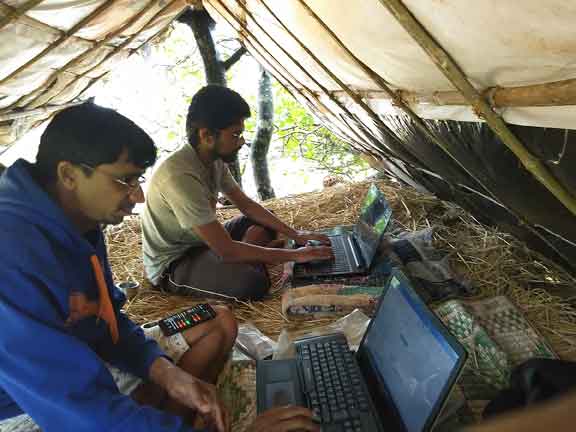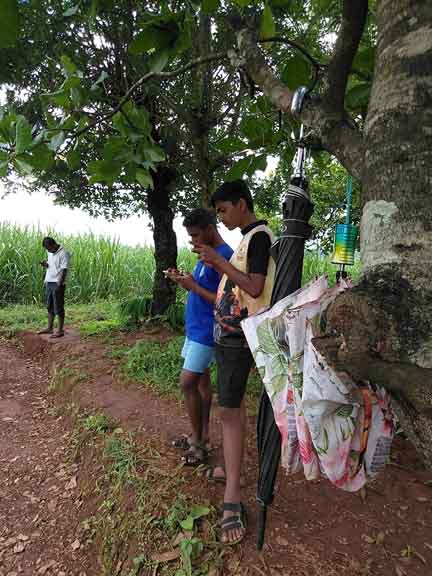Ambika Aiyadurai
The COVID-19 pandemic has disrupted and changed education in dramatic ways. Educational institutions were shutdown when the lockdown was imposed and now they are making efforts to go fully digital and gearing up for online education. Schools and universities are encouraging teachers to embrace e-learning. Teachers are being trained to acquire new skills through a variety of applications (Zoom, Webex, Google Meet) to adapt to the changing nature of teaching. Change is never easy, especially for teachers with several years of experience in the ‘chalk and talk’ mode. Like the teachers, students too were anxious about their classes and the upcoming semester. Quick emails and phone calls to my students helped me understand what kind of facilities they had at home, which would enhance or hamper learning opportunities. I teach ‘Politics of the Environment’, an elective course open to all students from B.Tech to PhD. My students come from across India, from Assam to Kerala. This article offers a glimpse into the lives of students who have been at home and are struggling with online classes.
Students in metro cities replied immediately that they would be able to access and attend online lectures and download pre-recorded videos. Haridhar, who lives in Tarpoli village in Kolkapur, Maharashtra, wrote back after four days. He wrote, “My village is in a very remote area surrounded by a jungle of Western Ghats. There is very bad network connectivity. I can’t access from home and always go out. Rainy days have started and the network connection gets lost many times. Please consider this situation. It will be difficult to be online to attend lectures. So please post it on YouTube. I will somehow go out with umbrella, download it on the mobile. I could watch it afterwards.”
Students in Tarpoli go out to the fields for better internet connectivity. The phone network is unreliable too. They have to step out of their homes even to receive or make phone calls. After some trial and runs, students in this village find a few designated spots where internet works. When it becomes too hot, they sit under a tree or on a machan, made for villagers to guard their farms. These farms are their new classrooms. In the evenings, it becomes dangerous to stay on the farms. Gaurs (Indian Bison) raid the farms and an encounter with one could be fatal. Haridhar later told me that a gaur attacked two villagers a week ago. One of them is seriously injured and the other died.

While the location of Haridhar’s village poses unique site-related issues, similar problems are faced by students living in towns where internet services are infact available. Ismail, a first-generation college-goer, lives in Kairana in Western UP. His father’s textile shop had to be closed due to the lockdown. Unable to cope with family problems, including lack of regular income and uncertainty of his education, Ismail is not able to sleep at night. He says, “I have been unsuccessfully trying to study at night. I don’t have space where I can sit and study peacefully. We live in a joint family, so only at night, there is less noise and disturbance as compared to the day. There is not good internet speed, and sometimes I have to go to an open field in search of good internet speed. Also sometimes, power cut problem is there in my locality. Due to all these reasons, it seems very difficult for me to attend online classes.” Students like Ismail face frustration, irritation and anxiety, which in turn lead to psychological problems.
The great digital divide in India is glaring. According to the National Sample Survey data for 2017-18, only 42 per cent of urban and 15 per cent of rural households have internet access. Access to internet does not mean that there is internet at home. Households having computers in rural India count for only 4.4 per cent and 23.4 per cent in urban India. In this survey, having smartphones was not considered.
There are four groups of students who require our attention and support: students from marginalized groups, those living in remote geographical locations, those with a non-conducive learning environment at home and those with some form of disabilities. These groups of students fall on the wrong side of the digital divide. With no support, they find it challenging to catch up with the rest of the class. “To access online lectures, I go to the terrace because there is no reception at home. It gets very hot there, but what to do. And during rains, I have to take care of my devices. If my laptop gets damaged, there is no way to repair quickly,” says Kumar who lives on the outskirts of Nanded. A crucial requirement of this new form of learning is highspeed internet connectivity. Without that the students’ struggle is magnified. A student told me he spends 4-5 hours to download my lectures. While official estimates show that in 2018, 93.9 per cent of rural households had electricity for domestic use, the supply of power is not regular. Kumar adds, “I have to keep a check on the charge of the mobile phone. There was no electricity for three days last week. Under such conditions, I give up.”
Most students use their smartphones to download and access online classes. In places like Kashmir with only 2G available, asking students to join classes and submit assignments online is outright unfair. There are detrimental psychological effects on students, especially from Jammu and Kashmir, who already face difficulties because of the political environment, military conflicts and technology-related barriers. A few students like Pasha have gone into depression. The day I called Pasha, he was at a clinic. When I enquired if everything was alright, he told me that he was depressed. “If there are online classes next semester, I would not be able to join. I have to withdraw for the semester. I live in a joint family and have family responsibilities. With a limited internet connection and things to take care at home, it isn’t easy to cope. It makes me feel unworthy.” Students living in remote mountainous areas of northeast India, Jammu and Kashmir and in forest areas of central India will be left behind and digitally excluded. Students from marginalized sections (scheduled castes and scheduled tribes) and students with disabilities, end up further excluded because of the already existing disadvantages and structural barriers.
 The nature of the classroom has changed. It is no longer formal and no longer an official space, it is the domestic family space. For many, this is not a comfortable space, especially for those living in non-nuclear families. According to Census (2011), the number of households in India with one-room homes, and two-room homes were 91.49 million (37 per cent) and 78.12 million (32 per cent) respectively. A single room house, noisy and congested can hardly be a space for students to focus on assignments or attend virtual classes. Lakshmi wakes up at 6 am. She helps her mother cook breakfast and lunch. Washing utensils and cleaning the house are her daily responsibilities. In her one-room home in a slum area in Pune, she waits for everyone to go to sleep and then study. “There are fights during the day time and people shout at each other. The sound from our neighbour’s television is often loud. There is never a quiet time. How can I sit and study?,” asks Lakshmi.
The nature of the classroom has changed. It is no longer formal and no longer an official space, it is the domestic family space. For many, this is not a comfortable space, especially for those living in non-nuclear families. According to Census (2011), the number of households in India with one-room homes, and two-room homes were 91.49 million (37 per cent) and 78.12 million (32 per cent) respectively. A single room house, noisy and congested can hardly be a space for students to focus on assignments or attend virtual classes. Lakshmi wakes up at 6 am. She helps her mother cook breakfast and lunch. Washing utensils and cleaning the house are her daily responsibilities. In her one-room home in a slum area in Pune, she waits for everyone to go to sleep and then study. “There are fights during the day time and people shout at each other. The sound from our neighbour’s television is often loud. There is never a quiet time. How can I sit and study?,” asks Lakshmi.
Believing that technology has the potential to reach out to all sections of the society is one thing, but the reality is something else. If educational institutions do not reach out to the digital have-nots and support them, they need to reflect on their sense of social responsibility and justice.
Every class may have 5-10 per cent (sometimes more) students who may need some kind of support, both materially and emotionally. We can take steps as teachers to make our classrooms as inclusive as possible. Institutions must have a policy for those students who are at home and who may need technical support (providing them with devices, posting books and pen drives with syllabus and readings), monetary support (a nominal amount for data usage) and emotional support. Setting up a hotline and helpline for students and parents could be a way to build confidence for those who may need support, both for academic queries and for emotional support from counsellors. Online education is also challenging us to rethink how to teach, how to engage with students and more importantly, how to evaluate students. To be flexible and adaptable without compromising the quality of teaching is the need of the hour. This needs out-of-the-box solutions. More importantly, as individual teachers and as institutions, we need to reach out to the students over phone calls and talk to them. This will go a long way in building confidence among students like Haridhar, Ismail, Laxmi and Pasha.
As teachers, we have to walk that extra mile to reach students who are at the edge and face the risk of dropping out. These students are waiting outside the ‘new classroom’ and they know that the classes have begun but because their background (geographic location, class, caste, gender, disabilities), they are unable to participate on the digital platforms. The first step is to recognize the factors contributing to the digital divide. Both at the institutional and individual level, we need to carefully consider and find ways to let these students come and join the virtual classrooms. If not, we would have failed in our roles as educators.
The author is Assistant Professor of Anthropology, Humanities and Social Sciences at the Indian Institute of Technology, Gandhinagar. She can be reached at a.ambika@iitgn.ac.in.
